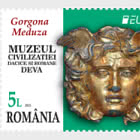Romfilatelia, the company specialized in issuing and trading Romanian postage stamps, releases the issue called Exotic Fishes, addressing both the fans of aquarium science as well as the stamp collectors.
Carassius auratus is illustrated on the stamp with a face value of 21,000 ROL. It is part of the Cyprinidae family, native from China. It is also known as the golden fish or the golden crucian carp. It has a great longevity (18 years) and it may reach up to 30-35 cm in length by the age of maturity. It is related to the carp, but its body is less flattened and has no whiskers. This is the oldest fish bred for ornamental purposes, with at least 1,000 years of selection breeding.
The stamp with a face value of 31,000 ROL illustrates the Symphysodon discus species, who is part of the Cichlidae family, native from the region of the Amazon. This species stands out by the interesting colouring of its body and of its fins (yellow-blue, with red hemming), but also by its circular shape. The fish may measure up to 23 cm in diameter. Having been a mystery for a long period of time, the reproduction of this species remains difficult even nowadays, when all the details about the perpetuation of the species are well-known.
The stamp with a face value of 36,000 ROL illustrates Labidochromis caeruleus, in great demand among the fans of aquarium science, due to its bright yellow colouring and Labidochromis zebroides, a striped fish, coloured blue with black stripes. Labdiochromis is part of the Cichlidae family and it is native of the Malawi Lake (Africa).
The stamp with the face value of 47,000 ROL illustrates the Betta splendens species who is part of the Anabantidae family, native from the South Eastern part of Asia (India, Thailand, Vietnam, Indonesia). It is also known by the name of the fighter fish, this name coming from the male’s bitterness in defending his own territory. It fights to such an extent that, if two males were to be put together in the same aquarium, they would fight each other until the elimination of one of them. The colouring may vary from yellow, blue, green or red to spectacular combinations between these colours.















































